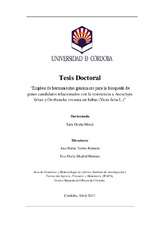Mostrar el registro sencillo del ítem
Empleo de herramientas genómicas para la búsqueda de genes candidatos relacionados con la resistencia a Ascochyta fabae y Orobanche crenata en habas (Vicia faba L.)
| dc.contributor.advisor | Torres, Ana M. | |
| dc.contributor.advisor | Madrid, Eva | |
| dc.contributor.author | Ocaña Moral, Sara | |
| dc.date.accessioned | 2017-06-29T10:21:16Z | |
| dc.date.available | 2017-06-29T10:21:16Z | |
| dc.date.issued | 2017 | |
| dc.identifier.uri | http://hdl.handle.net/10396/14850 | |
| dc.description.abstract | El objetivo principal de este trabajo ha sido desarrollar y explotar nuevas herramientas genómicas en habas para desvelar a nivel molecular posibles mecanismos de defensa frente al hongo patógeno Ascochyta fabae y la planta parásita Orobanche crenata, causantes de grandes pérdidas en su producción. Se ha pretendido ampliar la información genética sobre dichos mecanismos de resistencia e identificar posibles genes candidatos donde desarrollar marcadores diagnóstico que permitan extrapolar los resultados de QTL estables entre poblaciones y facilitar la selección precoz de materiales en sus programas de mejora. Para conseguir estos fines, se han empleado distintas herramientas genómicas (estructural, comparada y funcional). Así, en el capítulo II, se han utilizado la genómica estructural y la macrosintenia existente entre leguminosas, para saturar dos de los mapas genéticos disponibles por el grupo con marcadores relacionados con la resistencia a ambos patógenos, descritos en otras leguminosas. Dicha saturación, ha permitido refinar la posición de los QTLs existentes e identificar marcadores estrechamente ligados que podrían facilitar el proceso de selección. Además, el genotipado de estos nuevos marcadores ha ayudado al desarrollo de un mapa consenso para este cultivo. En el capítulo III, utilizando herramientas de genómica funcional, se ha tratado de profundizar en las rutas implicadas en la interacción planta-patógeno e identificar potenciales genes de resistencia que pudieran ser últiles en la mejora asistida por marcadores. Para ello se ha caracterizado el transcriptoma de dos líneas parentales (29H y Vf136) sometidas a la infección por A. fabae y obtenido sus perfiles de expresión génica. Aparte de proporcionar nueva información genómica, el estudio han revelado una amplia variedad de posibles mecanismos y rutas implicadas. El gran número SNPs e InDels identificados en los transcritos ofrece, además, una posibilidad rentable de saturar los mapas disponibles y de identificar genes responsables de la resistencia. Para finalizar, en el capítulo IV, se ha genotipado un conjunto de SNPs expresados diferencialmente entre ambos parentales, relacionados con mecanismos de resistencia. Ello ha permitido situar nuevos marcadores más robustos y transferibles (SNPs y ESTs) dentro de los intervalos de confianza de los QTLs de resistencia ya descritos, facilitando su comparación con otras poblaciones de habas y con otras leguminosas. | es_ES |
| dc.description.abstract | The main objective of this work has been to develop and exploit new genomic tools in faba bean in order to reveal at molecular level possible defense mechanisms against the pathogenic fungus Ascochyta fabae and the parasitic plant Orobanche crenata, causing severe yield losses in this crop. The approach aimed to expand the genetic information on the resistance mechanisms involved and to identify possible candidate genes useful to develop diagnostic markers for validation of stable QTL among populations and for the efficient selection of superior materials in breeding programs. To achieve these ends, different genomic tools (structural, comparative and functional) have been applied. Thus, in Chapter II, both the structural genomics and the synteny among legumes have been exploited to saturate two of the genetic maps available by the group using markers related with the resistance to both pathogens, described in other legumes. The saturation allowed to refine the position of the underlying QTLs and to identify closely linked markers that could facilitate the selection process. In addition, the new markers were used as a bridge to develop a consensus map in this crop. In Chapter III, functional genomics tools have been applied to gain insight into the pathways involved in the plant-pathogen interactions and to identify potential resistance genes to be further used in marker assisted selection. The faba bean transcriptome from leaves of two lines (29H and Vf136) subjected to A. fabae infection were characterized.in order to obtain its gene expression profiles. Apart from providing new genomic information, the study has revealed a wide variety of possible mechanisms and pathways involved. The large number of SNPs and InDels identified in the transcripts also offers a cost-effective way to saturate available maps and to identify genes responsible for resistance. Finally, in chapter IV, a set of differentially expressed SNPs between both parental lines, related with resistance mechanisms has been genotyped. The approach has allowed placing more robust and transferable markers (SNPs and ESTs) within the confidence intervals of the resistance QTLs already described, facilitating their comparison among faba bean and legume species. | es_ES |
| dc.format.mimetype | application/pdf | es_ES |
| dc.language.iso | spa | es_ES |
| dc.publisher | Universidad de Córdoba, UCOPress | es_ES |
| dc.rights | https://creativecommons.org/licenses/by-nc-nd/4.0/ | es_ES |
| dc.subject | Hongos patógenos | es_ES |
| dc.subject | Ascochyta fabae | es_ES |
| dc.subject | Plantas parásitas | es_ES |
| dc.subject | Orobanche crenata | es_ES |
| dc.subject | Vicia faba L. | es_ES |
| dc.subject | Habas | es_ES |
| dc.subject | Herramientas genómicas | es_ES |
| dc.subject | Mejora genética vegetal | es_ES |
| dc.title | Empleo de herramientas genómicas para la búsqueda de genes candidatos relacionados con la resistencia a Ascochyta fabae y Orobanche crenata en habas (Vicia faba L.) | es_ES |
| dc.type | info:eu-repo/semantics/doctoralThesis | es_ES |
| dc.rights.accessRights | info:eu-repo/semantics/openAccess | es_ES |

